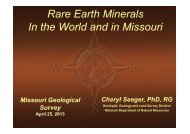You also want an ePaper? Increase the reach of your titles
YUMPU automatically turns print PDFs into web optimized ePapers that Google loves.
lbs) for 1957 and 450 kg (1,000 lbs) for 1958<br />
(K<strong>in</strong>g and Harris, 2002).<br />
The euxenite was reported by Houston (1961) to<br />
be metamict to the extent that it gave no x-ray diffraction<br />
pattern. His x-ray fluorescence studies of<br />
the euxenite showed, <strong>in</strong> order of decreas<strong>in</strong>g abundance,<br />
the presence of Nb, Y, Fe, Ta, U, and Zr.<br />
These were accompanied by m<strong>in</strong>or amounts of Pb,<br />
Mn, Zn, Er, Eu, Ac, Ho, Ti, Th, Sm, and Rn. K<strong>in</strong>g<br />
and Harris (2002) suggested that the euxenite crystals,<br />
reported to be up to 7.6 cm (3 <strong>in</strong>) long, might<br />
have been misidentified and were probably samarskite<br />
or niobium-rich, yttrium-bear<strong>in</strong>g tantalite.<br />
X-ray fluorescence of monazite from the Platt m<strong>in</strong>e<br />
showed, <strong>in</strong> order of abundance, Ce, Nd, Y, Th, and<br />
La. These were accompanied by m<strong>in</strong>or amounts of<br />
Pr, Sm, and Gd. Although phosphorus is a major<br />
constituent of monazite, its presence could not<br />
figure 9. Samples of the Big Creek – Platt pegmatites. A, Sample<br />
20120917JC-A. B, Sample 20120917BW-A.<br />
31<br />
be shown by the type of analysis used (Houston,<br />
1961).<br />
A 1980 DOE report (Adams and others, 1980)<br />
described both euxenite and allanite <strong>in</strong> several<br />
samples from the Platt pegmatite. Sample analyses<br />
<strong>in</strong> that report did not show any lanthanum,<br />
or yttrium concentrations higher than average<br />
crustal values. Scandium exceeded five times its<br />
average crustal value at 200 ppm. No other REE<br />
were evaluated <strong>in</strong> samples from the Platt pegmatite<br />
(Adams and others, 1980).<br />
The Platt M<strong>in</strong>e pegmatite dike trends approximately<br />
50˚. A sample collected for this <strong>in</strong>vestigation<br />
(Sample 20120917JC-A) is composed of muscovite<br />
granite pegmatite dom<strong>in</strong>ated by quartz, microcl<strong>in</strong>e,<br />
and perthite, with moderate plagioclase,<br />
and hematite with limonite sta<strong>in</strong><strong>in</strong>g. It conta<strong>in</strong>s<br />
m<strong>in</strong>or garnet, dendritic pyrolusite, epidote alteration,<br />
and a glassy black m<strong>in</strong>eral, possibly euxenite<br />
or columbite-tantalite (fig. 9a). The<br />
dike <strong>in</strong>trudes granitic gneiss (Sutherland<br />
and Hausel, 2005) with m<strong>in</strong>or<br />
biotite; band<strong>in</strong>g <strong>in</strong> the gneiss trends<br />
342˚, and dips 59˚ E. Analysis<br />
of sample 20120917JC-A shows<br />
enrichment <strong>in</strong> lutetium and ytterbium<br />
greater than five time crustal<br />
abundances; HREE are slightly<br />
enriched above crustal abundances.<br />
The sample is also enriched <strong>in</strong> niobium<br />
and tantalum. The analyzed<br />
values <strong>in</strong> this sample are a m<strong>in</strong>imum<br />
estimate for concentrations <strong>in</strong> this<br />
pegmatite dike because the relatively<br />
high silica content of the sample<br />
suggests dilution by excess quartz.<br />
When the analysis is normalized to<br />
the global average silica content of<br />
granite, 72.04 percent, (Blatt and<br />
Tracy, 1996) Er, Lu, Tm, Yb and Y<br />
are enriched above five times crustal<br />
abundance, as are niobium and tantalum<br />
(table 8). The high niobium<br />
and tantalum concentrations suggest<br />
that euxenite or columbite-tantalite<br />
may be present with<strong>in</strong> the pegmatite.



